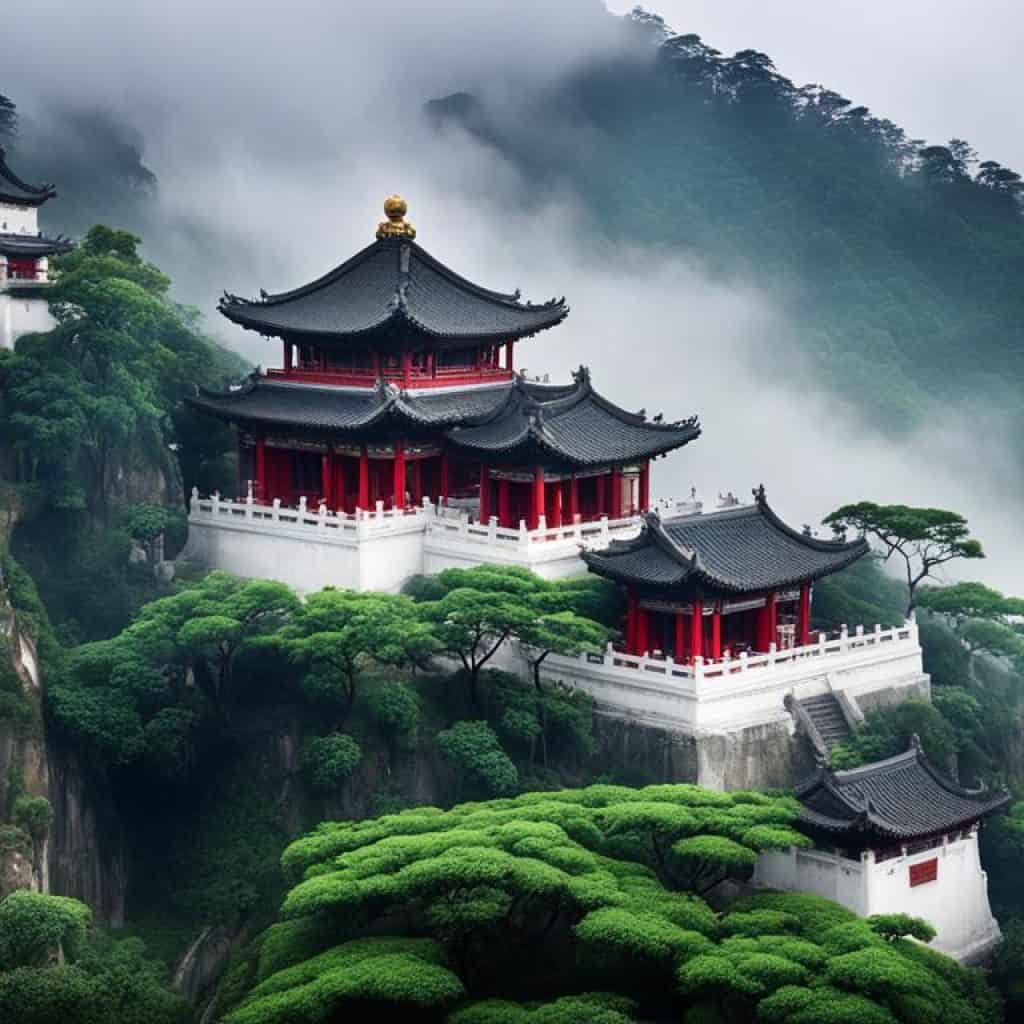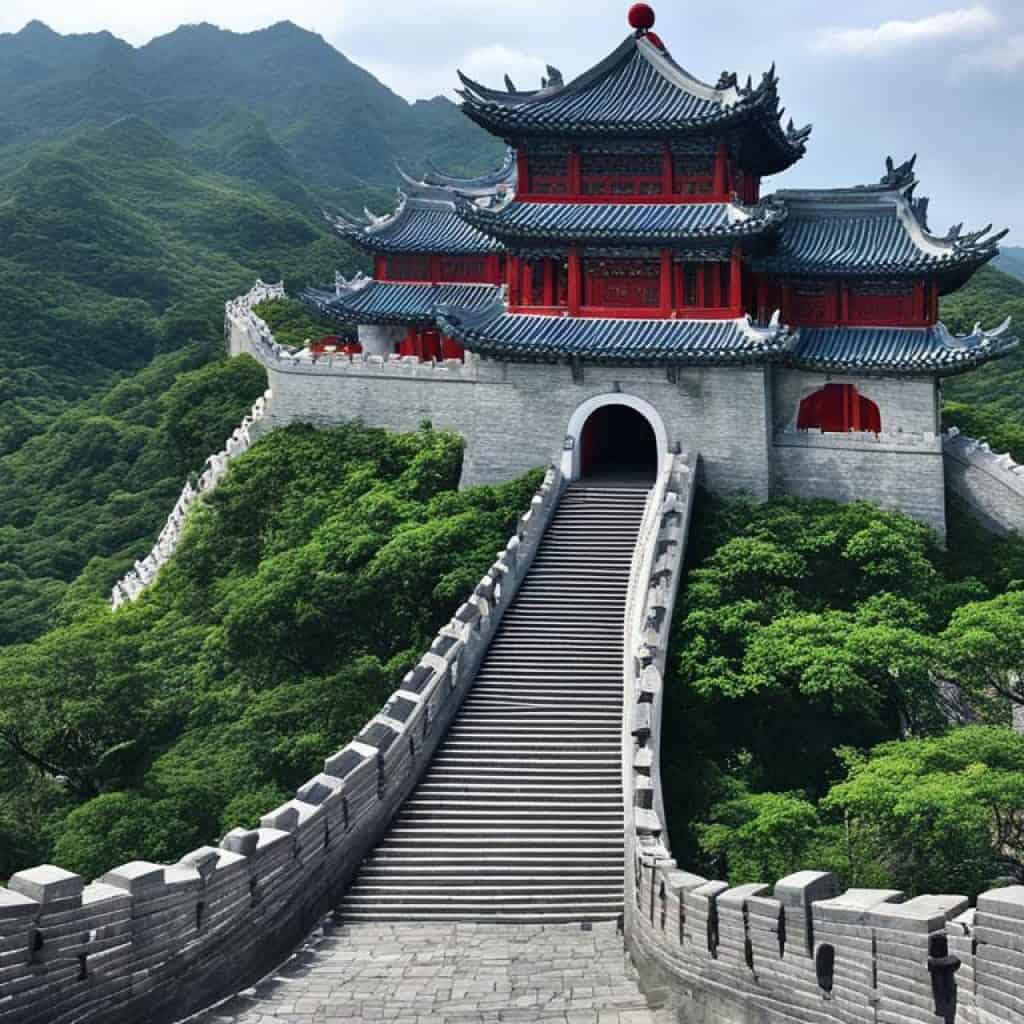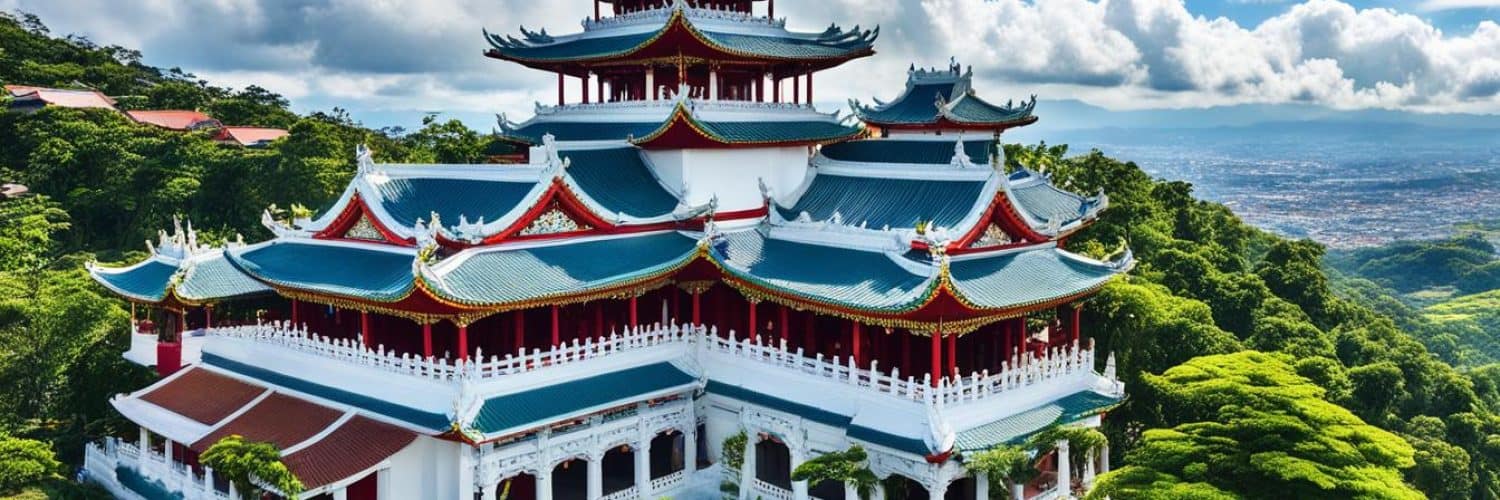Immerse yourself in the serenity of the Taoist Temple, a beacon of cultural heritage in the heart of Cebu City. This sacred haven not only stands as a significant Chinese temple but also offers a peaceful escape where peace and serenity flourish, enveloped by the energizing spirit of Taoism. Join countless visitors who have experienced the unique blend of spirituality and tranquility that this remarkable landmark in the Philippines generously provides.
Key Takeaways
- Discover the peaceful ambiance of the Taoist Temple amid Cebu City’s hustle.
- Appreciate the mingling of culture, spirituality, and architectural beauty.
- Understand the importance of preserving cultural heritage.
- Experience the tranquility that contributes to the temple’s restorative reputation.
- Explore the significance of Taoism and its lasting legacy in the Philippines.
- Embrace the calm and self-reflection offered by this treasured Chinese temple.
Unveiling the Taoist Temple, Cebu Philippines
As a renowned tourist destination and significant religious site, the Cebu Taoist Temple beckons travelers seeking tranquility and a deeper connection to spirituality. This cultural attraction is a testament to the harmonious blend of architectural design and serene landscapes in the heart of Cebu City.
A Peaceful Enclave in a Bustling City
Visitors routinely commend the temple for its capacity to instill a sense of calm amidst the city’s vibrant life. Testimonials from individuals like Makoto and Rossy D praise the site’s ambiance, which balances peaceful reflection areas with engaging spots such as a playground and scenic locations perfect for photography. This juxtaposition makes the Cebu Taoist Temple a unique haven of peace.
The Architectural Marvel of the Taoist Temple
The opulence of the temple’s architectural design is a source of fascination for many. Not only does its structure reflect the sophistication of traditional architectural forms, but it also embodies a spiritual allure that resonates with those who step into its sacred space. Despite its openness to the public, accentuated by Michael T’s 2023 mention of free entrance and no stringent dress code, the aura of the temple remains unperturbed, serving as a constant reminder of its spiritual essence. NPLim’s reflection underlines the need for visitors to uphold decorum befitting its status as a religious site.
Discover the Rich History of Taoism in Cebu
Immerse yourself in the captivating history of the Taoist Temple located in the heart of Cebu Philippines. Erected by the Chinese community in 1972, this emblematic religious site is not solely a sanctuary for worshippers but a reflection of the city’s tapestry of cultures. Nestled in the Beverly Hills Subdivision and elevated 300 meters above sea level, the Temple offers insights into the philosophical world of Taoism and celebrates the enduring legacy of the Chinese influence in Cebu.
The origins of the Taoist Temple stretch back over decades, symbolizing the religious beliefs and cultural values that the Chinese settlers brought with them. This historical beacon has since stood as a mirage intertwining the past and present of Cebu’s society. It is where pilgrims and tourists alike delve into the teachings of Lao Zi, whose wisdom continues to resonate within the walls of this sacred space.
| Year Established | Community | Elevation | Philosophy |
|---|---|---|---|
| 1972 | Chinese Community of Cebu | 300 meters above sea level | Taoism |
| Historical Significance | A testament to the spiritual contributions of the Chinese in the cultural evolution of Cebu. | ||
As visitors wander the grounds of the Temple, they are not merely sightseers but participants in an ongoing historical narrative. The Temple serves as a vital node connecting the contemporary landscape with the sacred history and traditions of the Chinese settlers who found a haven in Cebu’s dynamic milieu.
Navigating the Cultural Significance of the Chinese Temple
The Taoist Temple in Cebu City is a bastion of cultural significance and traditional belief systems. More than just a place of worship, this Chinese temple is a vibrant hub where Taoist rituals and beliefs manifest in the most authentic ways, offering visitors a unique glimpse into a spiritual world that has been carefully preserved over centuries.
Taoist Rituals and Beliefs Uncovered
The atmosphere within the Taoist Temple buzzes with the reverent energy of devotees and the curious whispers of visitors. Here, one can witness the intricate tapestry of Taoist worship, including the lighting of joss sticks, which fills the air with a sacred fragrance that aids meditation and prayer. Perhaps one of the most intriguing aspects for those new to Taoist beliefs is the practice of using “Kau Cim” or wooden blocks for oracle consultation, a method by which adherents seek guidance from the divine.
Understanding Respectful Visitation Practices
Embracing the spiritual essence of the temple requires more than just passive observation; it calls for respectful visitation. Visitors are encouraged to partake in the serene environs with reverence, whether it’s through silent prayer or reflection. The experience is enriched when visitors approach the temple with a mindset open to learning and respecting the Taoist way of life. Current reviews, such as those from Kocickasmom and Chi_Tiff in 2023, highlight the importance of engaging with the temple surroundings in a manner that honors its sacred nature, including adhering to a dress code that respects the modesty of the spiritual environment.
As one of Cebu’s most treasured spiritual landmarks, the Taoist Temple remains a powerful testament to the city’s rich tapestry of cultural influences and the enduring legacy of Taoist philosophy. With each respectful visitation, the intricate beliefs and rituals continue to etch themselves into the hearts of those who walk its sacred grounds.
Panoramic Views and Spiritual Serenity: A Visitor’s Perspective
Central to the visitor experience at the Taoist Temple in Cebu City is the impressive spectacle of panoramic views that greet the eye. Encompassed by the tapestry of Cebu’s undulating terrains, these views offer a compelling fusion of the urban skyline and the lush vegetation of Beverly Hills. It’s an immersive tableau that invokes a sense of spiritual serenity amidst the bustle of city life, as affirmed by visitors like Brian Austin Cartin and Makoto.

From this venerated location, one can witness the sun casting its golden hues over the metropolitan expanse, rendering a vibrant canvas that enthralls the soul and cements the Taoist Temple as a bastion of tranquility and reflection.
The panoramic views from the temple are a manifest blend of the natural world with the crafted sanctum of spirituality. They magnify the essence of the surroundings, creating a space where nature and human ingenuity conjoin to elevate the spiritual serenity of those who seek solace. Below we present a table of the views and aspects of the temple that significantly augment the visitor experience.
| Aspect of View | Description | Influence on Visitor Experience |
|---|---|---|
| Cebu’s Skyline | Expansive horizon with urban architecture | Highlights the contrast and harmony between the sacred space and the outside world |
| Beverly Hills Vegetation | Lush greenery that surrounds the complex | Provides a sense of immersion in nature, contributing to tranquility |
| Neighboring Islands | The visible contours of islands on the horizon | Instills wonder and the notion of expansive beauty beyond the temple |
In conclusion, the Taoist Temple of Cebu City doesn’t merely offer a glimpse into Taoist culture; it provides a panoramic experience that intertwines with the every breath of Cebu, fostering a profound sense of spiritual serenity that resonates deeply with visitors from around the world.
Exploring the Religious Site’s Architectural Splendors
The Taoist Temple in Cebu is not just a spiritual sanctuary; it is a beacon showcasing the architectural splendors of Chinese architecture. Visitors from around the world are captivated by its authentic Taoist Temple design, making it an iconic Cebu landmark. Intricate carvings, vibrant colors, and the harmonious fusion of form and function speak volumes about the temple’s religious and cultural importance. Here we delve into the elements that make this temple a masterpiece of design.
- The majestic entrance of the temple that mirrors the Great Wall of China provides an impressive welcome to all visitors, symbolizing strength and eternity.
- Colorful dragon motifs and bright lanterns along the temple repeatedly catch the eye, imbuing the atmosphere with a sense of wonder and respect for the rich cultural heritage.
- Architectural elements such as the pagoda-style rooftops and the carefully curated garden landscapes reflect both the philosophical aspects of Taoism and the traditional principles of Chinese garden design.
| Design Element | Description | Cultural Significance |
|---|---|---|
| Great Wall Replica Entrance | A grandiose entryway inspired by the iconic Great Wall | Represents historical resilience and grandeur |
| Dragon Motifs | Detailed carving of dragons weaving throughout the structure | Symbolizes power, strength, and good fortune |
| Pagoda-Style Rooftops | Multi-tiered roofing that ascends to the skies | Illustrates the ascent to enlightenment and connection to the heavens |
| Colorful Lanterns | Bright, ornate lanterns that illuminate the temple | Brings light and guidance, significant during festive seasons |
| Traditional Garden | Lush gardens with a harmonious arrangement of elements | Encapsulates the Taoist pursuit of balance and harmony with nature |
In essence, the Taoist Temple is more than just a place of worship—it captures the essence of Taoist philosophy through its architectural splendors. It stands as a living art piece, meticulously crafted, preserving the intricate details of traditional Chinese architecture, while serving as a spiritual haven and iconic Cebu landmark.
Engaging with the Sacred: Ceremonies and Rituals
The tapestry of Taoist rituals and sacred ceremonies weaves a spiritual narrative that is deeply embedded in the experience of visiting the Taoist Temple in Cebu. Every gesture and step within these grounds is an act of spiritual engagement, offering a window into the soul of Taoist philosophy.
The Ritual of Communicating with Divinity
One of the most profound aspects of a visit to the Temple is participating in the ritual using wooden blocks known as ‘Jiaobei’. This time-honored Taoist method allows adherents and guests alike to seek insights from the divine, posing questions to the gods and interpreting the way the blocks fall as answers. It is this ritual that fosters a connection between the material and spiritual realms, an integral part of Taoist Temple ceremonies.
Ascend the 81 Steps – A Taoist Pilgrimage
Symbolizing the ascent to enlightenment, pilgrims and visitors climb a total of 81 steps to reach the upper temple. Each step represents one of the 81 scriptures of Taoism, presenting a physically manifested journey of the scriptures. It stands as a monumental pilgrimage for devotees, who climb the steps as both exercise and devotion, reflecting their zeal for sacred ceremonies and the cultivation of spiritual wellbeing.
| Aspect of Ritual | Purpose | Experience |
|---|---|---|
| Jiaobei Blocks | Divination and Guidance | A tactile, mystical interaction with the divine |
| 81 Steps Ascent | Emulating the Study of Scriptures | A journey of reflection and commitment |
The Taoist rituals at the temple are more than mere traditions; they are the threads that connect the ancient teachings with the contemporary search for meaning. Through this confluence of sacred action and serene environment, the Taoist Temple stands as a bastion of spiritual enlightenment amidst the hustle and bustle of modern life.
A Journey to Relaxation: The Temple’s Tranquil Gardens and Spaces
Embarking on a relaxation journey to the Cebu Taoist Temple allows individuals to immerse themselves in the calm embrace of tranquil gardens and serene spaces. Within the walls of this spiritual retreat, visitors are greeted by a symphony of natural elements, intricately designed to create a spiritual oasis far from the stresses of daily life.
The lush greenery and ornamental fountains serve as a backdrop for a tableau of quiet reflection and inner peace. The gardens have been curated not only for their aesthetic pleasure but also for their ability to facilitate contemplative thought, meditation, and the Zen of simply being.
- Gentle sounds of trickling water from fountains calming the mind
- Floral scents mingling with incense creating a unique olfactory experience
- Shaded pathways that invite leisurely strolls or silent contemplation
In homage to the philosophies of Taoism, the Taoist Temple’s design harmoniously blends architectural elements with the natural world, establishing surroundings that are conducive to both spiritual pursuits and the quiet joy of being one with nature. This sacred place serves as a haven where the journey to relaxation is as significant as the destination itself.
| Feature | Description | Benefit |
|---|---|---|
| Ornamental Fountains | Elegant water features dotted throughout the garden | Instills a sense of calm and aids in meditation |
| Lush Greenery | Abundant plant life including bamboo groves and floral displays | Promotes relaxation and connection with nature |
| Quiet Corners | Secluded areas for individual contemplation | Offers a private space for personal reflection |
| Cultural Ambiance | Traditional Taoist aesthetics embedded in the landscape | Enhances the spiritual connection of visitors |
The Connective Pathways of Cebu City’s Religious Landmark
Embarking on a journey to discover the Taoist Temple’s grounds in Cebu City is an exploration of cultural fusion and spiritual symbolism. The comprehensive design of its premises intertwines connective pathways that guide visitors on a path that is as culturally rich as it is visually stimulating. These routes are more than mere walkways; they are narrative threads linking the physical space with the deeply rooted heritage of this storied religious landmark.

Access and Integrating Visitor’s Experience
The experience at the Taoist Temple begins with an awe-inspiring entrance, a Great Wall replica, sculpted to symbolize the journey from the bustling life of Cebu City to the peaceful enclave of mindfulness. This grand entrance ushers visitors into an environment designed to enhance reflection and understanding, commencing an integrated visitor experience filled with serenity and discovery.
From the Great Wall Replica to the Dragon-Adorned Rooftops
The transition from the towering walls to the intricately detailed dragon-adorned rooftops provides a visual narrative of the Temple’s protective and regal ethos. Dragons, revered for their strength and wisdom in Asian cultures, are not merely decorative; they serve as symbolic guardians overseeing the momentous journeys of each who walks the temple’s grounds. These architectural elements materialize a storyline that celebrates the duality of physical grandeur and spiritual grace, capturing the essence of what makes the Taoist Temple an important fixture on the cultural map of Cebu.
Integrating Harmony with Nature at the Taoist Temple, Cebu Philippines
Amidst the vibrant city life, the Taoist Temple in Cebu, Philippines, offers a serene retreat where harmony with nature is not just an aspiration, but a tangible experience. Visitors often speak of a profound sense of tranquility that envelops them as they traverse the temple grounds, a testament to the seamless integration between the sacred sanctuary and the natural elements that envelope it.
Each element within the temple’s design has been carefully selected to enhance the spiritual atmosphere. This careful curation of nature and architecture comes together to create a haven for reflection and meditation. The following table illustrates how the Taoist Temple marries natural beauty with its spiritual purpose:
| Element of Nature | Role in Spiritual Harmony |
|---|---|
| Gardens and Greenery | A symbol of growth and renewal, encouraging a sense of personal development. |
| Fountains and Water Features | Embodying the flow of life’s energies and the soothing sounds that promote inner peace. |
| Open Air Structures | Fostering open-mindedness and the breathing space for introspection. |
| Stunning Vistas | Providing panoramic views that remind visitors of the vastness and beauty of the world beyond. |
The union of natural elements with the spiritual realm is a core principle in Taoism, and the Cebu Taoist Temple captures this essence brilliantly. Whether it is the carefully manicured gardens emitting a sense of ecological balance, or the strategically placed statues that offer moments of contemplation, the temple grounds whisper the ancient Taoist philosophy of living in harmony with nature’s rhythm. The
“Nature does not hurry, yet everything is accomplished” – Lao Tzu
ethos radiates throughout every corner of the temple, creating an immersive experience that is both calming and uplifting.
As visitors meander through this tranquil oasis, there is a palpable connection to the earth’s grounding forces, enticing one to return to the basics of being and to rediscover the peaceful coexistence with the surrounding world. The Taoist Temple in Cebu stands not only as a religious landmark but also as a living embodiment of the peaceful interplay between humanity and the environment.
Visitor Etiquette and Practices at the Cultural Attraction
As you step through the ornate gates of the Taoist Temple in Cebu, it’s important to remember that this cultural heritage site is not only a scenic attraction but also a sacred space for many. Observing proper etiquette is essential to ensure a respectful and enriching experience. Let’s explore some guidelines for visitors.
Guidelines for a Respectful Tour
Awareness and respect are your best companions when visiting this emblem of peace and serenity. Here are some key points of etiquette to adhere to during your visit:
- Speak softly to maintain the tranquil atmosphere.
- Dress modestly, covering shoulders and knees as a sign of respect.
- Observe the spiritual rituals without intruding or disrupting.
- Remove your shoes before entering the prayer hall, following local custom.
Photography and Observation Protocols
While photography is allowed in many areas of the Taoist Temple, there are protocols that visitors must follow to respect the site’s sanctity:
- Always look out for signs indicating photography restrictions.
- Seek permission before taking photos of any worshippers or rituals.
- Use the opportunity to observe and learn about Taoist practices rather than just capturing images.
- Do not use flash photography inside the temple as it may disturb others.
Following these guidelines for a respectful tour ensures that both you and the site’s regular patrons can continue to appreciate this unique cultural attraction for many years to come.
The Serendipitous Escape: A Personal Reflection on Visiting the Taoist Temple
When urban noise and the relentless march of time begin to weigh on the spirit, the promise of a serene getaway beckons at the Taoist Temple of Cebu City. Perched atop Beverly Hills, the site offers more than just a glimpse into cultural tradition; it offers an envelope of tranquility where one’s thoughts can meander through stillness and introspective calm. As the visitor’s journey transports them away from the frenetic tempo of the metropolis below, they encounter an unexpected renewal of peace.
Each carved statue, each meticulously manicured garden space echoes the symphony of silence, emphasized by the occasional whisper of the temple’s devotees. It is here among the rising incense and the folds of dragon sculptures that presence finds precedence over the past and the future. For many who visit, the Taoist Temple is more than a destination; it is a serendipitous escape, a place that gently nudges the weary traveler back to their center.
Let us unravel this personal pilgrimage through a tableau of experiences that loyal visitors and first-timers share:
| Aspect of Visit | Visitor Impressions | Cultural Takeaway |
|---|---|---|
| Panoramic Views | Unrivaled skyscapes of Cebu City; a feast for the lens and the soul alike. | Interplay of nature and spirituality; the grandeur of existence. |
| Architectural Grandeur | The confluence of tradition and artistic expression through form and color. | A narrative in stone and space; the story of cultural identity and continuity. |
| Atmosphere of Serenity | A feeling of detachment from the temporal, replaced by sublime peace. | An encounter with inner tranquility; the essence of spiritual harmony. |
The Taoist Temple of Cebu is an amalgam of silent tales murmured by the winds that course through its open spaces. These stories, told in the footsteps of those who walk its grounds, convey the universal human quest for meaning, beauty, and a momentary pause in the storm of life.
In this sanctuary, the dichotomy of a tourist site and spiritual haven dissolves, shaping an intimate narrative that lingers on the edge of memory, prompting a return to this oasis where the horizon of the sea meets the solace of the soul.
Conclusion
As our exploration of the Taoist Temple in Cebu draws to a close, it’s evident that this sanctuary offers far more than a retreat from the pulsating energy of the city. It encapsulates the fusion of culture, spirituality, and natural splendor, leaving an indelible mark on all who wander its sacred grounds. The collective experiences shared by travelers and devotees alike construct a vivid tapestry that portrays the temple as an essential thread in the cultural fabric of Cebu City.
The Lasting Impressions of Taoist Temple on Tourists
The temple’s capacity to imbue a sense of peace and serenity in visitors is a recurring sentiment shared by many. Whether it’s the awe-inspiring architecture, the tranquil gardens, or the panoramic city views, the lasting impressions extend well beyond the confines of its walls. Reviewers, photographers, and spiritual seekers have immortalized the temple in their narratives and images, ensuring that its essence lives on in the hearts of those who have had the privilege to experience its wonders.
Why the Taoist Temple in Cebu is a Must-Visit Destination
To appreciate the full breadth of Cebu’s historical and cultural mosaic, a visit to the Taoist Temple is imperative. It’s not just a feast for the eyes or a testament to architectural genius, but also a gateway into understanding the profound spiritual and cultural connections that define this vibrant community. Without doubt, the Taoist Temple stands as a beckoning beacon for explorers, promising a journey that transcends the conventional tourist path and ventures into the realms of inner peace and cultural enlightenment.
FAQ
What is the Taoist Temple in Cebu known for?
The Taoist Temple in Cebu is recognized for its peaceful environment, cultural heritage, and architectural marvel. It’s a place where visitors can enjoy tranquility amidst the bustling Cebu City and explore the spiritual practices and beliefs of Taoism.
Can you provide some information on the history of the Taoist Temple in Cebu?
Established in 1972 by the local Chinese community, the Taoist Temple serves as a testament to the cultural diversity of Cebu. Perched 300 meters above sea level, it reflects the historical and spiritual contributions of the Chinese in the region and represents the teachings of the ancient Chinese philosopher Lao Zi.
Are there specific rituals to observe at the Taoist Temple?
Yes, the Taoist Temple in Cebu allows visitors to engage in self-reflective activities such as lighting joss sticks in the hall of worship and participate in oracle consultation using wooden blocks. It’s also a site where people can partake in spiritual pilgrimages, including climbing 181 steps representing the 81 Taoism scriptures.
What are the respectful visitation practices at the Chinese Temple?
Visitors are advised to maintain composure and be mindful of the temple’s primary function as a religious site. Dress respectfully, avoid loud noises, and engage with the space in a way that preserves its sanctity and allows for personal and communal reflection.
What are the architectural highlights of the Cebu Taoist Temple?
The architecture of the Taoist Temple incorporates traditional Chinese designs, including an entrance resembling the Great Wall of China, colorful dragon motifs, and intricate lanterns. Its design is a harmonious blend of spirituality and modern Chinese cultural influence.
Is there a fee to enter the Taoist Temple in Cebu City?
No, entrance to the Taoist Temple is free of charge, but donations are welcome to support the maintenance of the Temple and its grounds.
What should tourists expect in terms of scenic views at the Temple?
The Temple’s elevated location in Beverly Hills Subdivision provides visitors with stunning panoramic views of Cebu City’s landscape. The picturesque backdrop includes sweeping vistas that extend across the city and toward neighboring islands, amplifying the serene and spiritual experience.
What can one find in the tranquil gardens and serene spaces of the temple?
The temple’s gardens and serene spaces feature ornamental fountains, lush greenery, and soothing natural sounds, offering visitors a relaxing and reflective escape from the city’s hustle and bustle.
What are the different ways to access the Taoist Temple?
The Taoist Temple can be accessed through multiple entrances, including a replica of the Great Wall of China and pathways guarded by impressive dragon statues. These unique elements contribute to the immersive cultural and religious experience of visiting the Temple.
Can photography be enjoyed within the Temple complex?
Photography is allowed within the Temple grounds, as it is considered a cultural attraction. However, visitors should observe respect for religious practices and the privacy of worshippers. Look out for any signage indicating restricted areas for photography.
Are there any dress codes or etiquette to follow when visiting the Temple?
While there’s no strict dress code, modest attire is recommended to honor the spiritual nature of the Temple. Visitors should dress appropriately to access all areas of the complex and should avoid disrupting the serene atmosphere with loud noises or inappropriate behavior.
What makes the Taoist Temple a must-visit destination in Cebu?
The Taoist Temple is a unique blend of cultural, historical, and spiritual significance. Its stunning architecture, peaceful gardens, and immersive rituals offer a glimpse into the practice of Taoism and provide a culturally enriching experience for both tourists and spiritual seekers alike.











Add comment